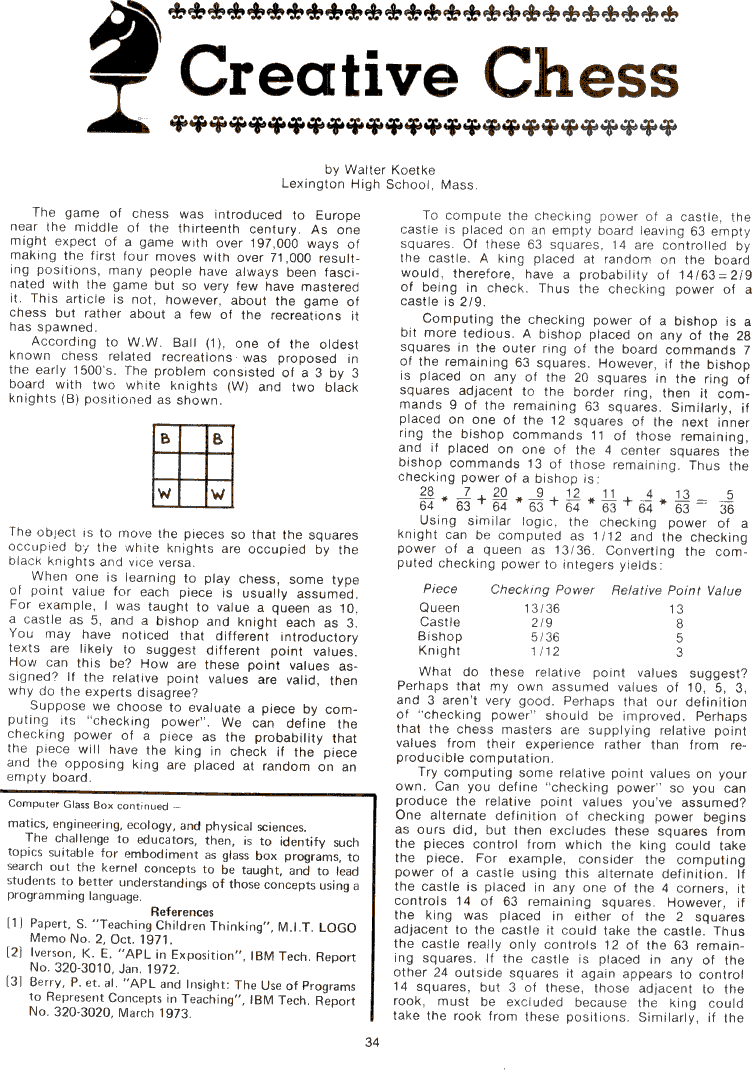by Walter Koetke

éééééééééééééééééééééééééé Creative Chess éééééééééééééééééééééééééé by Walter Koetke Lexington High School. Mass. The game of chess was introduced to Europe near the middle of the thirteenth century. As one might expect of a game with over 197,000 ways of making the first four moves with over 71,000 resulting positions, many people have always been fascinated with the game but so very few have mastered it. This article is not, however, about the game of chess but rather about a few of the recreations it has spawned. According to W.W. Ball (1), one of the oldest known chess related recreatlons was proposed in the early 1500's. The problem consisted of a 3 by 3 board with two white knights (W) and two black knights (B) positioned as shown. BIB III WIW The object is to move the pieces so that the squares occupied by the white knights are occupied by the black knights and vice versa. When one is learning to play chess, some type of point value for each piece is usually assumed. For example, I was taught to value a queen as 10, a castle as 5, and a bishop and knight each as 3. You may have noticed that different introductory texts are likely to suggest different point values. How can this be? How are these point values assigned? If the relative point values are valid, then why do the experts disagree? Suppose we choose to evaluate a piece by computing its "checking power". We can define the checking power of a piece as the probability that the piece will have the king in check if the piece and the opposing king are placed at random on an empty board. *** Computer Glass Box continuedmatics, engineering, ecology, and physical sciences. The challenge to educators, then, is to identify such topics suitable for embodiment as glass box programs, to search out the kernel concepts to be taught, and to lead students to better understandings of those concepts using a programming language. *** References *** [1] Papert, S. "Teaching Children Thinking", M.l.T. LOGO Memo No. 2, Oct. 1971. [2] Iverson, K. E. "APL in Exposition", IBM Tech. Report No. 320-3010, Jan. 1972. [3] Berry, P. et. al. "APL and Insight: The Use of Programs to Represent Concepts in Teaching", IBM Tech. Report No. 320-3020, March 1973. To compute the checking power of a castle, the castle is placed on an empty board leaving 63 empty squares. Of these 63 squares. 14 are controlled by the castle. A king placed at random on the board would, therefore, have a probability of 14/63=2/9 of being in check. Thus the checking power of a castle is 2/9. Computing the checking power of a bishop is a bit more tedious. A bishop placed on any of the 28 squares in the outer ring of the board commands 7 of the remaining 63 squares. However, if the bishop is placed on any of the 20 squares in the ring of squares adjacent to the border ring, then it commands 9 of the remaining 63 squares. Similarly, if placed on one of the 12 squares of the next inner ring the bishop commands 11 of those remaining, and if placed on one of the 4 center squares the bishop commands 13 of those remaining. Thus the checking power of a bishop is: 28 7 20 9 12 11 4 13 5 --*--+--*--+--*--+--*-- = -64 63 64 63 64 63 64 63 36 Using similar logic, the checking power of a knight can be computed as 1/12 and the checking power of a queen as 13/36. Converting the computed checking power to integers yields: *** Piece Checking Power Relative Point Value Queen 13/36 13 Castle 2/9 8 Bishop 5/36 5 Knight 1/12 3 What do these relative point values suggest? Perhaps that my own assumed values of 10, 5, 3, and 3 aren't very good. Perhaps that our definition of "checking power" should be improved. Perhaps that the chess masters are supplying relative point values from their experience rather than from reproducible computation. Try computing some relative point values on your own. Can you define "checking power" so you can produce the relative point values you've assumed? One alternate definition of checking power begins as ours did, but then excludes these squares from the pieces control from which the king could take the piece. For example, consider the computing power of a castle using this alternate definition. If the castle is placed in any one of the 4 corners, it controls 14 of 63 remaining squares. However, if the king was placed in either of the 2 squares adjacent to the castle it could take the castle. Thus the castle really only controls 12 of the 63 remaining squares. If the castle is placed in any of the other 24 outside squares it again appears to control 14 squares, but 3 of these, those adjacent to the rook, must be excluded because the king could take the rook from these positions. Similarly, if the

